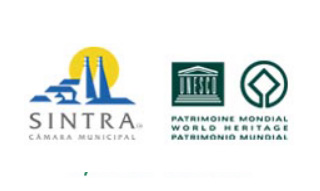The National Palace of Sintra is also known as Palácio da Vila (Town Palace) and was one of the Portuguese royal palaces.
It is located in the centre of the town. Building started in the 15th century, but the author of its design is unknown.
![]() The palace has characteristics of medieval, Gothic, Manueline, Renaissance and Romantic architecture.
The palace has characteristics of medieval, Gothic, Manueline, Renaissance and Romantic architecture.
It is considered to be an example of organic architecture, joining bodies that are apparently separate but which are part of an interconnected whole, by means of courtyards, stairs, corridors and galleries.
It has the largest collection of Mudéjar tiles in the country.
It is dominated by two large twin chimneys that crown the kitchen and constitute the ex-libris of Sintra.
The palace was used by the Portuguese royal family until practically the end of the monarchy, in 1910. In 2008, it was the most visited palace in Portugal, with 408,712 visitors.
http://www.sintraromantica.net/en/monuments/national-palace-of-sintra#sigFreeId6a211e2382
Situated in the town’s historic centre, the National Palace of Sintra is a unique monument, distinguished by its outstanding historical, architectural and artistic value.
Of all the palaces built by the Portuguese monarchs throughout the Middle Ages, only the palace of Sintra has survived to the present day virtually intact, still maintaining the same essential features of its shape and outline since the mid-16th century. The main building campaigns that took place after the Christian Reconquest in the 12th century were sponsored by the kings Dinis, João I and Manuel I, between the end of the 13th century and the mid-16th century. These campaigns consisted of adaptations, enlargements and general improvement works that have given the palace its present-day appearance.
The Moorish Palace
The town’s citadel
The first references to palatial structures in Sintra date from before the Christian Reconquest. The Arab geographer Al-Bakrî (11th century) mentions two extremely solid-looking castles in Sintra (source: Al-Himyarî, a Muslim geographer and historian). These must have been the one situated on the top of the hills, which still bears the name of the Moorish Castle even today, and the one that existed on the site of the present-day palace, built next to the village itself in the old medina. It was used as the home of the Moorish governors, and, after 1147, as the residence of the Christian kings, following the conquests of Santarém and Lisbon.
In a Royal Charter dated 1281, King Dinis, who was aware of the need to ensure the upkeep and maintenance of the Crown’s property in Sintra (mea palacia, as the buildings were referred to by the king himself), granted special privileges to the free Moors from the neighbouring town of Colares who worked on the conservation and renovation of his Sintra Palace: the Moorish Palace that now belonged to the Crown as a result of the conquest and which was situated inside a walled enclosure.
One of the three views (1509) drawn by Duarte d’Armas (1465-?) – which have become invaluable iconographic sources since they preceded King Manuel I’s building campaigns – shows some constructions on the left that have since disappeared, bearing the legend of Meca (a place name evoking the old Moorish Palace that was still in place at the beginning of the 16th century?). Shortly afterwards, King Manuel ordered the Tower of the Coat of Arms Room to be erected upon this site.
The Royal Palace
The main building campaigns
After the recapture of Sintra, it was some time before the Portuguese kings began to frequent the Palace on a more regular basis, especially after Lisbon had established itself as the headquarters of the central power. Its closeness to the capital, its privileged climate and landscape, its abundance of agricultural provisions and exceptional hunting grounds were decisive factors in the choice of Sintra as the Court’s refuge during the summer months.
King Dinis (reigned, 1279-1325) was probably the first king to become interested in the SintraPalace once the borders of the Portuguese territory had been established. His quarters were situated at the highest point of the building, to the north, next to the Palatine Chapel, which had been built at his orders. This chapel still survives today and is one of the oldest parts of the palace. It has since become known as the Bedroom-Prison of King Afonso VI.
The Palace’s great transformations and enlargements date from the period of King João I (reigned, 1385-1433), in the first quarter of the 15th century with the building works that have been attributed to João Garcia de Toledo. The new palace was made much more spacious and stately, with the apartments being organised around the Central Patio. Juxtaposed and intercommunicating, these rooms had a variety of functions, which are partly described in the manuscript entitled Measurement of the Sintra Houses, left to us by King Duarte. The most notable feature of the building constructed in the time of King João is its main façade, which faces the town and is almost completely occupied by the Swans Hall, the Palace’s most stately room. The set of rooms annexed to this hall were distributed according to a criterion of increasing privacy, following the model of several antechambers (the Magpies Room, King Sebastião’s Room, the Mermaids Room, where the wardrobe was located, and the Julius Caesar Room), the chamber or bedroom (the Arab Room) and the backchamber (the Guest Room). In this way, the rooms that were furthest away from the Swans Hall were the most private and intimate spaces. Completing this set of rooms were the kitchens, built on the eastern side, with their two conical chimneys, which have become the palace’s distinguishing feature and the hallmark of the town of Sintra itself.
The building campaigns undertaken by King Manuel I (reigned, 1495-1521) were designed to embellish and improve the Palace, their most notable contribution being the decorative features in the Manueline style (doors and windows) and others in the Mudejar style (glazed tile coverings), as well as two new structures that were added to the royal palace and enhanced its grandeur: the east wing, which was used to house King Manuel’s apartments, and the Tower crowned by the Coat of Arms Room.
Over the following centuries, few alterations were made that had a profound impact on the Palace’s shape and appearance and the most significant event to have taken place there after King Manuel’s reign was the imprisonment of the deposed King Afonso VI, an episode that marked the end of the most intense period of royal residence at the Palace.
The National Palace of Sintra was designated a National Monument in 1910 and forms part of the Cultural Landscape of Sintra, classified by UNESCO as World Heritage since 1995.
In 2013, the Palace became a member of the Network of European Royal Residences
Timetable and Prices:
http://www.parquesdesintra.pt/planear-a-sua-visita/horarios-e-precos/
Largo da Rainha Dona Amélia
2710-616 Sintra
Tel.: 21 923 73 00 / 21 923 73 36
E-mail: info@parquesdesintra.pt / comercial@parquesdesintra.pt
www.parquesdesintra.pt
Palácio Nacional de Sintra
38º 47’ 50,50” N
9º 23’ 25,87” W


 Português
Português
 English (UK)
English (UK)







